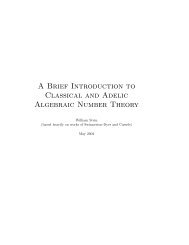p-ADIC HEIGHTS OF HEEGNER POINTS AND ANTICYCLOTOMIC ...
p-ADIC HEIGHTS OF HEEGNER POINTS AND ANTICYCLOTOMIC ...
p-ADIC HEIGHTS OF HEEGNER POINTS AND ANTICYCLOTOMIC ...
You also want an ePaper? Increase the reach of your titles
YUMPU automatically turns print PDFs into web optimized ePapers that Google loves.
14 JENNIFER S. BALAKRISHNAN, MIRELA ÇIPERIANI, <strong>AND</strong> WILLIAM STEIN<br />
If the point P ∈ E(F ) reduces<br />
• to the identity in E(k℘) for all primes ℘ | p, where k℘ is the residue field of F at ℘, and<br />
• to a non-singular point at all primes of bad reduction,<br />
then we have the following formula (see Mazur-Stein-Tate [12]) for computing the cyclotomic p-adic<br />
height of P :<br />
(5.1) hp,F (P ) = 1<br />
p ·<br />
⎛<br />
⎝ <br />
logp(NF℘/Qp (σ℘(P ))) − <br />
⎞<br />
ordv(dv(P )) · logp(#kv) ⎠ ,<br />
℘|p<br />
where σ℘ is the p-adic sigma function at the prime ℘ and kv is the residue field of F at v. Note that<br />
this assumes that we are working with a minimal model of E/F .<br />
Suppose now that F has class number 1. Then since <strong>OF</strong> is a principal ideal domain, there is a<br />
global choice of denominator d(P ) and the above formula (5.1) simplifies to the following:<br />
(5.2) hp,F (P ) = 1<br />
p · log ⎛<br />
⎝<br />
p<br />
<br />
<br />
σ℘(P )<br />
NF℘/Qp d(P )<br />
⎞<br />
⎠ .<br />
℘|p<br />
Note that our point P does not necessarily satisfy the two conditions listed above; in order to<br />
use the above formulas we compute the height of mP , where m ∈ Z is such that mP does reduce<br />
appropriately. Then we use that the height pairing is a quadratic form to recover the height of P .<br />
We now need to compute the denominator d(mP ) of mP . We start by computing the denominator<br />
d(P ) of P . If α is an algebraic number an integer denominator of α is some positive integer d such<br />
that dα is an algebraic integer. Naturally d is not unique, since any positive multiple of d is also an<br />
integer denominator of α. The notion of integer denominator is computationally useful and easy to<br />
compute, since we represent algebraic numbers in terms of a power basis.<br />
Algorithm 5.1 (Denominator d(P ) of P ∈ E(F ) with F of class number 1).<br />
(1) Input P = (x, y), where P ∈ E(F ).<br />
(2) Read off an integer denominator d := d(x) of x, and consider the ideal (x) = (d·x)<br />
(d)<br />
, where<br />
(d · x) and (d) denote <strong>OF</strong> -ideals.<br />
(3) Simplify (x) = (d·x)<br />
(d) by canceling common prime ideals in the numerator and denominator<br />
ideals.<br />
(4) What is left in the factored denominator ideal is a perfect square of prime ideals in <strong>OF</strong> , and<br />
the square root of this ideal is generated by the desired denominator d(P ).<br />
One could repeat the above process for mP ∈ E(F ), but this may be infeasible due to the<br />
numerical explosion in the coordinates of mP . Instead, we make use of m-division polynomials to<br />
write d(mP ) in terms of d(P ). Using Proposition 1 of [19], we easily deduce the following:<br />
Proposition 5.2. Let F be a number field of class number one, fm the m-th division polynomial<br />
of an elliptic curve E/F , and P ∈ E(F ) a non-torsion point that reduces to a non-singular point in<br />
E(kv) for every bad reduction prime v. Then the denominators d(P ), d(mP ) ∈ <strong>OF</strong> are related as<br />
follows:<br />
d(mP ) = fm(P )d(P ) m2<br />
.<br />
Proof. By Proposition 1 of [19] we know that<br />
v∤p<br />
d(mP ) = ufm(P )d(P ) m2<br />
,<br />
where u ∈ F is a unit in the completion of F at every finite prime. Since F has class number 1 it<br />
follows that u is a unit in <strong>OF</strong> . Then as d(mP ) is only defined up to units the result follows.
















